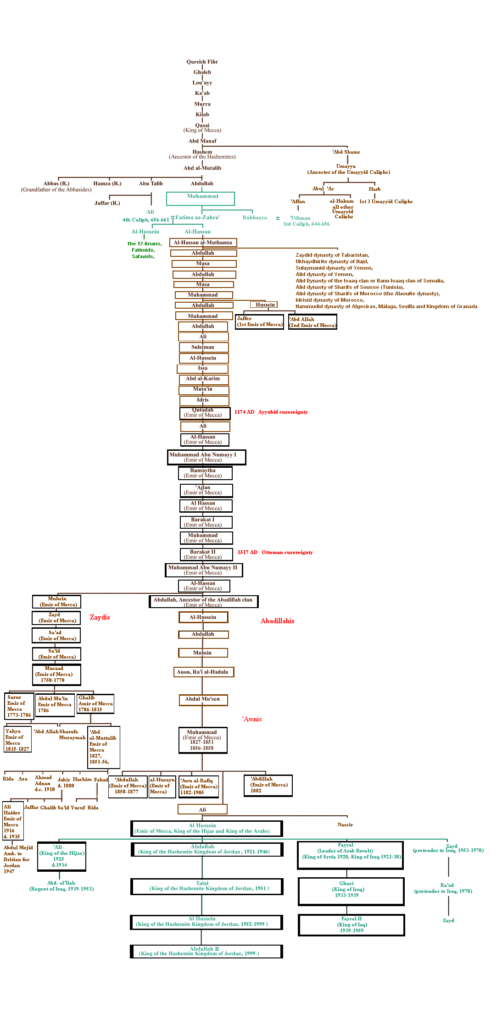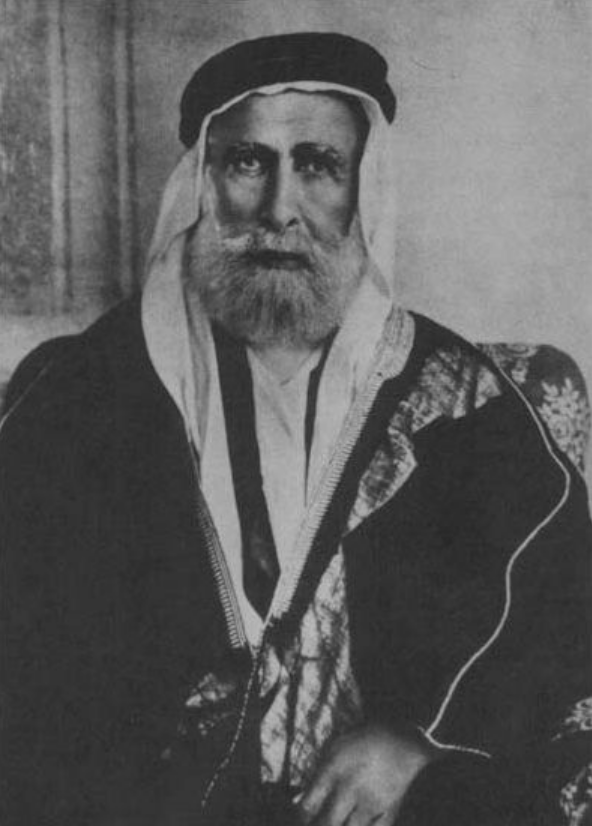The History of the Hashemite Dynasty

By Liam Nagle / Arab America Contributing Writer
Several of the states in the Arab world are ruled by monarchies; Saudi Arabia, Oman, and Morocco are just a few examples of monarchies that exist there. However, only a few monarchical families can claim ancestry back to the Prophet Muhammad himself – one of these is the Hashemite Dynasty. Also called the House of Hashim, the Hashemites currently rule the country of Jordan – but this wasn’t always the case. This article will delve into the history of the Hashemites, and how they got to where they are now.
Description and Claim

The Hashemites, known as al-Hāshimiyyūn in Arabic, is a family lineage within the Dhawu Awn, one of the branches of the Hasanid Sharifs of Mecca. This title grants them stewardship over the holy sites of Mecca and Medina, a position the family has held for multiple generations. They received this title after one of their ancestors, Ja’far ibn Muhammad al-Hasani, conquered Mecca and Medina in the name of the Fatimid Caliphate.
They also claim that their family lineage can be traced back to two individuals within Muhammad’s family – Hashim ibn Abd Manaf, the great-grandfather of the Prophet Muhammad, and Hasan ibn Ali, the grandson of the Prophet. Some other families have also claimed relation to the Prophet Muhammad through either the great-grandfather and grandson, with the ‘Alawi Dynasty that currently rules Morocco being the only current ruling family (other than the Hashemites) that claim ancestry to both.
History as Sharifs of Mecca

Ever since Ja’far ibn Muhammad al-Hasani’s conquering of Mecca and Medina, and his subsequent honor by being titled the Sharif of Mecca, his descendants within the Hashemite lineage have generally ruled – with interruptions – as Sharifs of Mecca for almost a millennia. This rule continued despite changes in power in the Middle East. An example of this can be seen when the Ottomans conquered Mamluk Egypt in 1517, causing the Hashemite Sharif of Mecca to proclaim his support for the Ottomans. However, a series of events in the modern era led to the Hashemites losing their position as Sharifs of Mecca.
The Sharifs of Mecca remained Hashemite up until the reign of Hussein bin Ali. A Hashemite himself, Hussein bin Ali had grandiose views for a new Islamic caliphate – one that would unite all of the Arabs together under his rule. When World War One broke out in 1914, and the Ottoman Empire went to war with the British and French, these two empires were more than willing to help Hussein bin Ali if it meant he would fight against the Ottomans. Hussein agreed, starting the Arab Revolt against the Ottomans in 1916 with British and French assistance. Forming the Kingdom of Hejaz, the Arabs under Hussein – as well as British troops – successfully beat back the Ottomans to as far as northern Syria before World War One came to an end.
However, his dreams of creating an Arab-led caliphate wouldn’t come to fruition. The British and French interests in the region conflicted with his own, as they wanted to establish their own colonies in the area after the Ottoman collapse. Three different states would be created for Hussein and his sons to rule – under British and French auspices. Hejaz would be ruled by Hussein, Syria ruled by Faisal, and Iraq ruled by Abdullah. But these plans began to fall apart as quickly as they began. Abdullah rejected to rule in Iraq, instead choosing to move to the Transjordan region and create his own state there with British supervision. In Syria, the pro-independence sentiment within Faisal’s administration led to France outright invading the territory, deposing Faisal who fled and took over rulership in Iraq.
Hussein in Hejaz, meanwhile, fared no better. Feeling betrayed by the British, he fell out of Britain’s favor after the war, who shifted their support to the neighboring ibn Saud family. This family subsequently invaded Hejaz in 1924-1925, deposing Hussein and taking the title of Sharif of Mecca for themselves. Nearly a millennia of Hashemite rule over Mecca and Medina was brought to an end. Now, the Hashemites only nominally ruled Iraq and Transjordan, which was largely under British control.
History as Rulers of Jordan and Iraq

Although Faisal and Abdullah would both die in 1933 and 1951 respectively, the Hashemite dynasty continued to rule in both countries after their deaths. Both countries would achieve their independence from the British under the Hashemite dynasty, with Iraq achieving independence in 1932 and Jordan in 1946.
However, in spite of these successes, Hashemite rule in Iraq would come to a bloody end. Faisal’s grandson, Faisal II, would assume leadership of the country at a very young age following his father’s death in 1939. In spite of Iraq’s claimed independence in 1932, the country under Faisal II remained supportive of British endeavors in the country – such as its stake in the oil industry. The rise of Pan-Arabism in the Middle East and North Africa in the 1940s and 50s resulted in dissident voices rising in Iraq who were discontent with Faisal II’s rule. Finally, a military coup known as the 14 July Revolution deposed Faisal II – and the Hashemites in Iraq – for good. Faisal II, most of his family, and retinue were all killed; their bodies defiled by crowds before being buried in unmarked graves.
Hashemite rule in Jordan, meanwhile, would continue into the modern day – although it was not without its issues. Abdullah I would be assassinated in 1951 by a Palestinian who seemingly blamed him for Palestine’s loss in the First Arab-Israeli War in 1948. He would be briefly succeeded by his son, Talal, who would be forced to abdicate by his parliament due to him suffering a mental illness that made him unfit to rule. He was succeeded by King Hussein of Jordan, who assumed rule at the age of 17. A very controversial figure both within Jordan but also internationally, he would then be succeeded by his son and currently-ruling monarch, Abdullah II in 1999. As such, the Hashemites continue to rule Jordan to this day.
Check out our Blog here!








